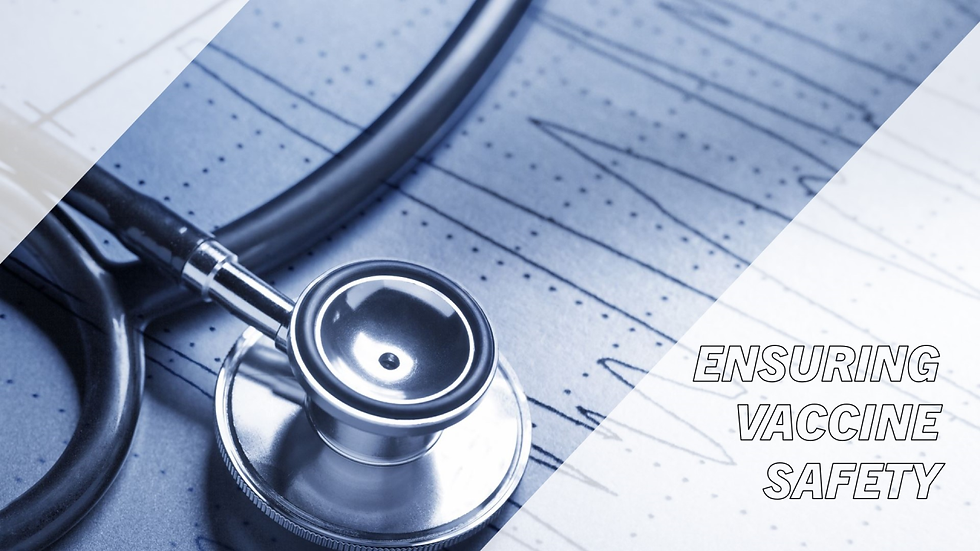How Vaccine Safety Databases Ensure Comprehensive Adverse Event Monitoring
- Chaitali Gaikwad
- Jun 27, 2024
- 3 min read

Monitoring vaccine safety is critical to ensuring public health. This blog explores how vaccine safety databases play a vital role in comprehensive adverse event monitoring, ensuring transparency and confidence in vaccination programs.
Importance of Vaccine Safety Monitoring:
Vaccination is one of the most effective public health interventions, preventing millions of deaths globally from infectious diseases. However, ensuring the safety of vaccines is paramount to maintaining public trust and confidence in immunization programs. Vaccine safety monitoring systems are essential for detecting and investigating adverse events following immunization (AEFI), which can range from mild reactions to serious, albeit rare, side effects.
Components of Vaccine Safety Monitoring Systems:
1. Pre-Licensure Clinical Trials
Phase Trials: Conducted to evaluate vaccine safety and efficacy in controlled settings before regulatory approval.
Post-Authorization Studies: Continuously monitor vaccine safety in real-world conditions after approval.
2. Post-Marketing Surveillance Systems
Passive Reporting Systems: Relies on healthcare providers and the public to voluntarily report AEFIs to regulatory authorities or health agencies.
Active Surveillance: Proactively monitors AEFIs through data collection from healthcare databases, electronic health records (EHRs), and other sources.
3. Vaccine Adverse Event Reporting Systems (VAERS)
Purpose: VAERS collects and analyzes reports of AEFIs from healthcare providers, vaccine recipients, and manufacturers.
Data Analysis: Enables rapid detection of potential safety signals for further investigation.
Global Vaccine Safety Databases and Initiatives:
1. Global Vaccine Safety Initiative (GVSI)
Role: Facilitates collaboration among international partners to monitor vaccine safety and share data.
Database Integration: Harmonizes surveillance efforts to enhance global vaccine safety standards.
2. Vaccine Safety Datalink (VSD)
Database: Maintained by the CDC in the United States, linking vaccination data with EHRs from multiple healthcare organizations.
Research Studies: Conducts studies on vaccine safety and monitors AEFIs in diverse populations.
3. European Medicines Agency (EMA) Database
Edra Vigilance: Collects and analyzes reports of suspected AEFIs from EU member states, supporting regulatory decision-making.
Risk Assessment: Conducts ongoing safety assessments and communicates findings to healthcare professionals and the public.
Role of Pharmacovigilance in Vaccine Safety:
1. Pharmacovigilance Systems
Adverse Event Reporting: Ensures timely reporting and analysis of AEFIs to detect safety signals.
Risk Communication: Provides information on vaccine safety to healthcare professionals, regulators, and the public.
2. Collaboration with Healthcare Providers
Training and Education: Equips healthcare providers with knowledge and tools to recognize, report, and manage AEFIs effectively.
Advisory Committees: Engage experts to review safety data and make recommendations on vaccine use.
Challenges and Mitigation Strategies:
1. Underreporting
Enhanced Surveillance: Implement strategies to improve reporting rates through education and simplification of reporting processes.
Public Awareness Campaigns: Educate the public about the importance of reporting AEFIs and how to do so.
2. Causality Assessment
Expert Panels: Convene expert panels to assess causality between vaccines and reported AEFIs, considering individual health profiles and medical histories.
Research Studies: Conduct epidemiological studies to investigate potential associations and inform regulatory decisions.
Ensuring Transparency and Public Confidence:
1. Data Accessibility
Open Access: Provide stakeholders with access to aggregated vaccine safety data while protecting individual privacy.
Data Sharing: Collaborate with international partners to exchange information and enhance surveillance capabilities.
2. Risk-Benefit Communication
Evidence-Based Communication: Communicate transparently about vaccine safety, addressing both benefits and risks based on scientific evidence.
Timely Updates: Provide updates on safety assessments and regulatory decisions to maintain public trust.
Future Directions in Vaccine Safety Monitoring:
1. Advanced Surveillance Technologies
Digital Surveillance: Utilize AI and machine learning to enhance real-time monitoring of vaccine safety signals.
Big Data Analytics: Analyze large datasets to identify rare AEFIs and trends across diverse populations.
2. Global Collaboration
Harmonization Efforts: Standardize vaccine safety monitoring protocols and data sharing practices globally.
Capacity Building: Support low-resource countries in strengthening their pharmacovigilance systems and vaccine safety infrastructure.
Conclusion:
Vaccine safety databases and monitoring systems are integral to safeguarding public health by ensuring the timely detection and assessment of adverse events following immunization. Through continuous surveillance, data analysis, collaboration, and transparent communication, stakeholders can maintain confidence in vaccination programs while addressing emerging safety concerns effectively. As technologies and global partnerships evolve, the future of vaccine safety monitoring holds promise for enhancing public health outcomes worldwide.

Comments